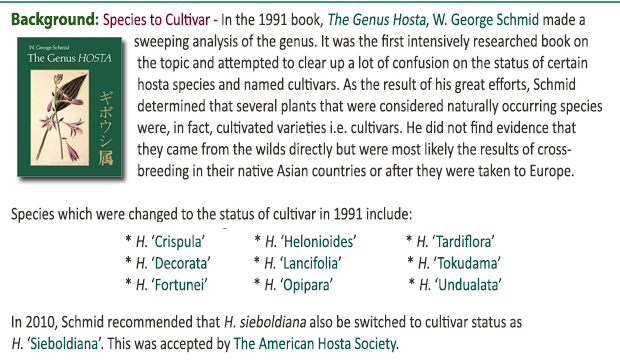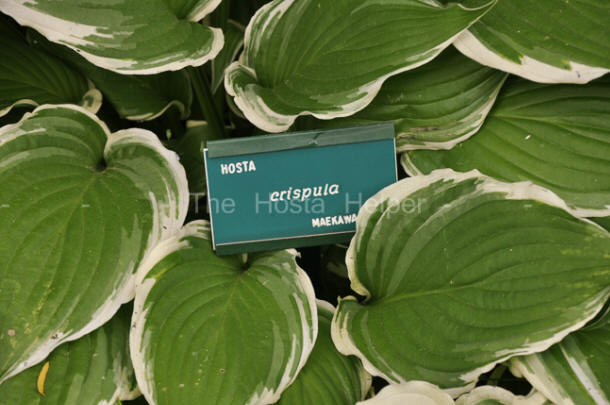|
  This
large size (24 inches high by 20 inches wide) hosta
of unidentified parentage was originated by
Dr. Fumio Maekawa of Japan. He named it as a species, Hosta
crispula but
George
Schmid in his 1991 book reduced it to cultivar status. It
was registered by
The American Hosta Society
in 2001 on behalf
of the originator, Dr Maekawa as a H. montana type of hosta. This
large size (24 inches high by 20 inches wide) hosta
of unidentified parentage was originated by
Dr. Fumio Maekawa of Japan. He named it as a species, Hosta
crispula but
George
Schmid in his 1991 book reduced it to cultivar status. It
was registered by
The American Hosta Society
in 2001 on behalf
of the originator, Dr Maekawa as a H. montana type of hosta.
'Crispula' is noted
for a slow growth rate. It has medium to dark green
foliage with white marginal variegation. The leaves
are shiny on top and wavy with a twisted tip. Near
white, funnel shaped flowers bloom from June into
July. It sets viable seeds.
This cultivar has been awarded
the Royal Horticultural Society's Award of Garden Merit in the
UK.

According to
The Hostapedia by Mark Zilis (2009), "Though known for more than one hundred years,
'Crispula' continues to be an outstanding choice as a
white-edged cultivar for landscaping purposes. It has a
distinctive appearance and a good show of flowers as well as a
good growth rate...it has become apparent that 'Dewline' and 'Crispula'
are the same plant."
In the
The Hosta Handbook by Mark Zilis (2000), noted that this plant has been known
as H. 'Dr. Jamison Harrison' in the past. It may also have been
sold as 'Mackwoods No. 4'.
The New Encyclopedia of Hostas by
Diana
Grenfell (2009) states: "Slow to establish and difficult to propagate. The
"true" H. 'Crispula' is less often seen in
cultivation since the 1960s and is used very little
as a breeding plant, although its descendent, H. 'Rocky
Mountain High', is one of the few exceptions. Prone to virus
infection...The leaves twist 180 degrees.
Decorative, flowerlike bracts extend the length of
the scape."

 An article about H. 'Undulata' and its origins by
Bob Solberg in
The
Hosta Journal (1996 Vol. 27 No. 1) states that, "H. 'Crispula'
is an interspecific hybrid of
H. sieboldii x
H. montana collected from the wild
in Japan and not a mutation of
H. montana alone. The most compelling evidence is
that leaf vein count is intermediate between
H. montana and
H. sieboldii and the
pollen type of H. 'Crispula' and
H. sieboldii is identical...While the data
presented here strongly support these conclusions, they do not provide absolute
proof. DNA testing of these cultivars would prove very interesting." An article about H. 'Undulata' and its origins by
Bob Solberg in
The
Hosta Journal (1996 Vol. 27 No. 1) states that, "H. 'Crispula'
is an interspecific hybrid of
H. sieboldii x
H. montana collected from the wild
in Japan and not a mutation of
H. montana alone. The most compelling evidence is
that leaf vein count is intermediate between
H. montana and
H. sieboldii and the
pollen type of H. 'Crispula' and
H. sieboldii is identical...While the data
presented here strongly support these conclusions, they do not provide absolute
proof. DNA testing of these cultivars would prove very interesting."


-0119.jpg)









 |



